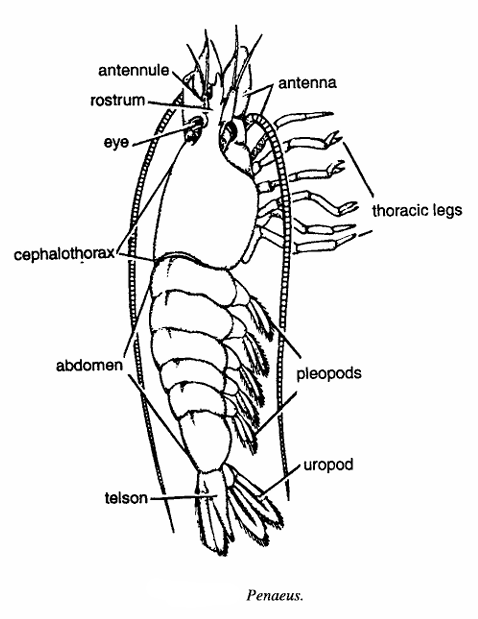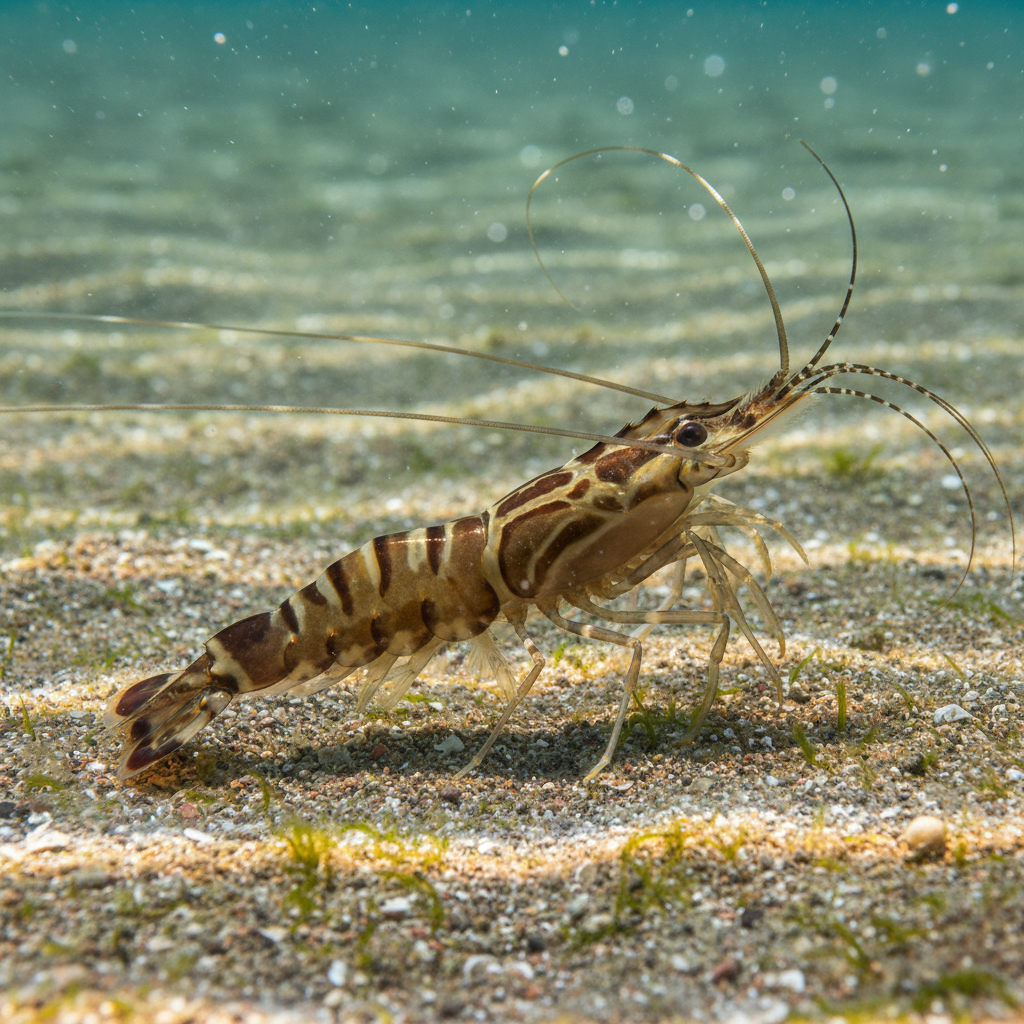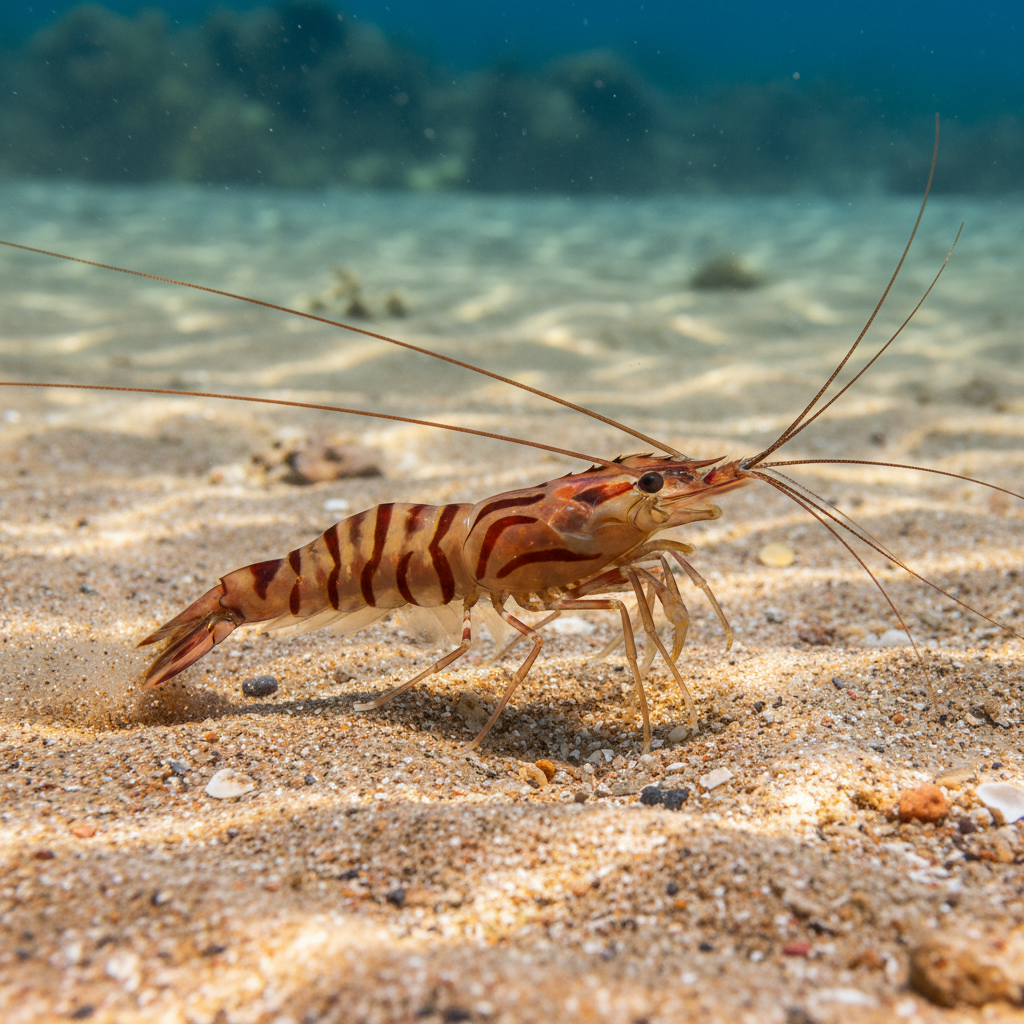Penaeus: Morphology, Classification, Habitat, and Economic Importance of Penaeid Shrimps
Penaeus is a genus of large prawns within the family Penaeidae, well known for species such as the giant tiger prawn (Penaeus monodon), which is among the most important farmed crustacean species worldwide. Penaeid shrimps are commercially vital in fisheries and aquaculture due to their large size, quality meat, and wide distribution. Members of this genus are characterized by their robust bodies, well-developed rostrum, and distinctive reproductive structures. They inhabit coastal marine waters, especially estuarine and brackish environments favorable for breeding and juvenile development.
Classification of Penaeus (Prawn)
| Taxonomic Rank | Name | One-line Characteristics |
|---|---|---|
| Kingdom | Animalia | Multicellular eukaryotes |
| Phylum | Arthropoda | Segmented invertebrates with jointed appendages |
| Subphylum | Crustacea | Mostly aquatic arthropods with exoskeleton |
| Class | Malacostraca | Largest class of crustaceans with ten legs (decapods) |
| Order | Decapoda | Ten-legged crustaceans including shrimps and crabs |
| Suborder | Dendrobranchiata | Prawns with branched gills and distinct reproductive traits |
| Superfamily | Penaeoidea | Prawns with elongated bodies and well-developed rostra |
| Family | Penaeidae | Commercially important penaeid shrimps |
| Genus | Penaeus | Large penaeid shrimps including farmed and wild species |

Habit and Habitat
Penaeus species occupy coastal and estuarine habitats with sandy or muddy substrates. They are benthic, spending much of their time on or near the sea floor. Juveniles often develop in brackish and mangrove areas where they find shelter and ample food. Adults migrate to deeper coastal waters to spawn and feed.
These shrimps are omnivorous, feeding on detritus, small invertebrates, and plankton.
Geographical Distribution
Penaeus species have wide and largely tropical to subtropical geographical ranges. Notably, Penaeus monodon is found in the Indo-West Pacific region, including the coasts of Australia, Southeast Asia, and the Indian Ocean. Other species are distributed in the Atlantic, Mediterranean, and Americas, depending on the species.

General Characteristics
- It is commonly called as prawn.
- The preserved specimen is orange-pink in colour having thin integument.
- Body is divided into an anterior rigid cephalothorax, posterior flexible abdomen and a post segmental terminal telson.
- All these divisions contain appendages. Cephalothorax is formed of 6 cephalic and 8 thoracic segments.
- Head contains 2 prominent eyes, very long antennae and short antennules.
- Endopodite of the first maxiIIula is elongated Walking legs are attached to thorax and the exopodite and endopodite. and segmented. first three pairs of legs are chelate.
- Each leg bears Abdomen consists of 6 segments and contains swimmerets of biramous swimming pleopods.
- They lack finger-like processes called appendix intemae on their exopodites.
- Abdomen is laterally compressed but not bent sharply.
- Pleopods are biramous and devoid of appendix intemae.
- Pleura of the second abdominal segment do not overlap those of the first.
- Development includes nauplius, protozoaea and zoaea stages.
- Body Size: Varies widely among species, with P. monodon reaching up to 36 cm.
- Rostrum: Long, toothed rostrum projecting from the head.
- Carapace: Smooth and glabrous with clear sulci and spines.
- Legs: Five pairs of walking legs, first three often with pincers (maxillipeds).
- Color: Depends on species; tiger prawn has distinctive dark stripes.
- Reproduction: Separate sexes with well-developed copulatory and brooding structures.
Special Features
- Rapid Growth: Suitable for commercial aquaculture with high growth rates.
- Leaf-like Gills: Branched gills facilitate respiration in varying oxygen conditions.
- Reproductive Structures: Specialized petasma in males and thelycum in females.
- Euryhaline: Some species tolerate wide salinity ranges, facilitating aquaculture.
- Economic Importance: A major source of seafood, supporting global shrimp markets.

Identification
Penaeus species are identified by:
- Rostrum shape, length, and number of dorsal and ventral teeth.
- Carapace grooves and spines.
- Color patterns and size.
- Morphology of petasma and thelycum reproductive organs.
- Geographic origin and habitat.
Life Cycle and Reproduction
Penaeus shrimp have complex life cycles including multiple larval stages such as nauplius, protozoea, mysis, and postlarva before settlement. Adults spawn in offshore deeper waters, with larvae dispersing planktonically. Juveniles migrate to estuarine nurseries for growth before returning offshore.
Reproductive output is high; females release eggs directly into the water, unlike some other decapods.
Ecological Role and Importance
- Trophic Role: Serve as both predator and prey in marine food webs.
- Fisheries: Support multi-billion-dollar shrimp fisheries worldwide.
- Aquaculture: Critical to global seafood industry with extensive farm production.
- Biodiversity: Maintain ecosystem functions through predation and scavenging.
- Environmental Indicator: Population health signals marine ecosystem status.
References
- Wikipedia – Penaeus
https://en.wikipedia.org/wiki/Penaeus - WoRMS – Penaeus monodon
http://www.marinespecies.org/aphia.php?p=taxdetails&id=210378 - Animal Diversity Web – Penaeus Classification
https://animaldiversity.org/accounts/Penaeus/classification/ - ScienceDirect – Penaeus Overview
https://www.sciencedirect.com/topics/agricultural-and-biological-sciences/penaeus

